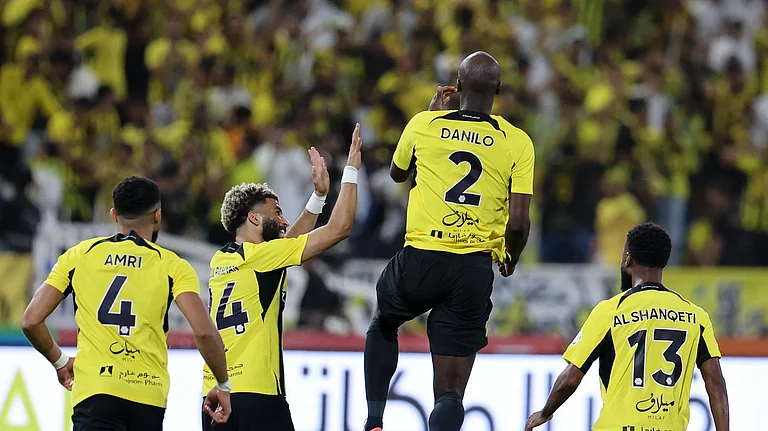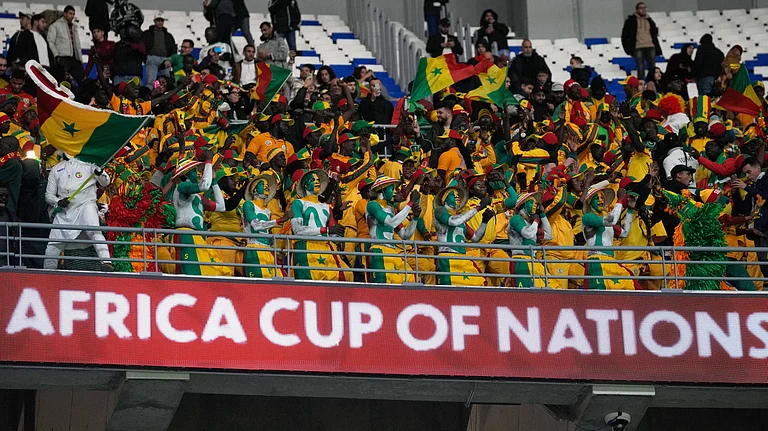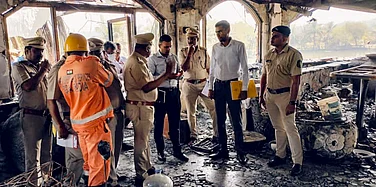On Pakistan, you once said that map-making in the subcontinent should cease...
continue to believe that 50 years after independence, one must stop playing atmap-making. I think what I've said is fairly explicit. What I'm aspiring to achieve isstability, and stable, defined international boundaries.
And if one doesn't have an international boundary?
Then one must seek it.
—Foreign Minister Jaswant Singh in an interview to The Indian Express, January 28,1999
Twenty days later, as Jaswant Singh was preparing to accompany Prime Minister AtalBehari Vajpayee to Lahore, he was asked to elaborate on his map-making comment. Hisriposte was typical: "I cannot elaborate it cartographically." But Singh'sinterview articulated the government's readiness to recognise the Line of Control (LoC) asthe international boundary between Pakistan and India. Obviously, this isn't as simple asit sounds. Just last week, the foreign minister harked to 1994 when then prime ministerP.V. Narasimha Rao midwifed a resolution in Parliament declaring all of Jammu and Kashmir,including the parts annexed by Pakistan and those in turn gifted to China, as irreversiblyIndia's.
Yet, our Framework For Peace in Kashmir starts with the clear recognition that theLoC must be converted into the international boundary (see table ). For one,Pakistan is not going to give up those areas under its control. Nor has India madeimpressive efforts to reclaim those territories. This objective reality of five (formally,three) decades isn't expected to change. Ever. That the government respects the LoC wasimplicit during the Kargil war, when troops and planes didn't stray beyond it and poundedonly the Pakistani positions on our side of the LoC.
Says Rajya Sabha MP Kuldip Nayar, "We also had a unanimous resolution in Parliamentthat vowed to take back every bit of territory from China. But our policy suggests that weare content with upholding the status quo." Since the border war with China in 1962,the territories reclaimed by successive governments have been less than notional. Pointsout Rajindar Sachar, a former chief justice of the Delhi High Court, "Technically,the 1994 resolution is not an act or a statute. It has no legal validity and it expiredwith that Lok Sabha."
Outlook's Framework emerged after an examination of ideas and proposals that havebeen in existence in Track II diplomacy. What we did was to filter out the moreunrealistic ideas. This process included discussions with personalities representing abroad spectrum of opinions. Says a former US ambassador to Pakistan, Robert Oakely,"In my non-expert view, you have a package of very sensible ideas which could form asubstantial part of an India-Pakistan agreement on Kashmir…. These ideas have indeedbeen identified by Farooq Kathwari's Kashmir Study Group (ksg) as well as in Indo-PakTrack II discussions. They are well known to senior government officials and politicalleaders in India and Pakistan and to the Kashmiri leadership on both sides."
The introduction to the ksg's proposals—Kashmir: A Way Forward—explains that inDecember 1998, some members of the ksg, "in consultation with several Indians andPakistanis", developed the package. Further, it says that "the reaction frommany people in South Asia, while guarded, was generally positive, and suggestions weremade to develop the ideas further.... Based on these suggestions, a more extended set ofproposals were put forward in 1999."
What Outlook has done is to comb some of the elements in the ksg proposals in orderto make it acceptable to all the parties concerned. All the people Outlook talked toagreed on record that the LoC should be fomally sealed. This opinion finds its echo in theOutlook-mdra opinion poll: only a small section think it is realistic to expect Pakistanto relinquish the parts of Kashmir it occupied (the higher number logged by those againstthe LoC as border only reminds us of the hardline opinion that still exists). Anoverwhelming majority believe it isn't possible to resolve the Kashmir imbroglio withoutinvolving Pakistan. And despite the shrill negative spin that greeted Vajpayee's suddenred-carpet approach to Gen Pervez Musharraf, most people polled in the fourmetros—where cynicism in these matters is a highly cultivated art—welcome theinitiative (see box).
It is equally true that Kashmir isn't merely a bilateral problem. Any possible solutionmust address itself to the grievances of Kashmiris. Outlook's Framework consequentlysatisfies all the three constituencies—Kashmir, India and Pakistan. For, the currentreality rules out a plebiscite—no Indian government can survive thisdecision—and yet accommodates the wishes of the people of Jammu and Kashmir,including those of Pakistan-occupied Kashmir (PoK), subject, obviously, to the LoC beingrecognised as the border bilaterally.
Even Musharraf thinks independence is not an option for Kashmiris. Sample his thoughtsculled from an interview he gave to the Pakistani newspaper The Nation on October 23 lastyear:
A plebiscite was offered in Kashmir by the United Nations in 1948. Do you still wantit?
Yes. Certainly. That is our position.
What if the people of Kashmir vote for independence?
There is no room for that. They have to vote either for India or for Pakistan.
Kashmiris have little leverage on the independence option. And Kashmiri nationalismremains only a profound dream, despite the heavy price they continue to pay for it.
Musharraf, too, knows it isn't realistic to expect India to abjectly concede Kashmir toPakistan. This was illustrated in his bbc interviews last week. Musharraf thought the pasthas not been "very attractive. Why talk about Kargil? If we go a few years down theline, we will arrive at Siachen. All that is history. We need to move ahead, look aheadwith optimism." He also said that if the talks on Kashmir registered progress, hewould be willing to exert his influence on jehadis operating in Kashmir.
This is a condition New Delhi can live with. Soft borders and the other aspects of theFramework—free movement of people from Kashmir to PoK, intra-Kashmir trade,etc—can become a reality if Musharraf lives up to his promise of curbing cross-borderterrorism. This could be the essence of a grand bargain: Pakistan reduces violence andboth New Delhi and Islamabad take concrete measures to bring the Kashmiris on both sidesof the LoC closer to each other.
Argues Sumit Ganguly, a professor at the University of Texas at Austin, "The keyquestion is whether the Musharraf-Sattar (Pakistan's foreign minister) team can deliver.Already, Sattar is crowing that Pakistan's hardline strategy has paid off handsomely. Ifhe continues in this asinine vein, all he can expect is a cold reception from Vajpayee inDelhi.All the hoopla associated with these talks will simply dissipate in New Delhi'sfetid summer air." Although he doesn't see the "soft borders" as an optionthat can come about soon, he concedes that it could be part of a larger, morecomprehensive peace accord between India and Pakistan.
The grand bargain should obviously contain a comprehensive autonomy package thatsatisfies both the national interest as well as the aspirations of Kashmiris (seetable). Explains George Perkovich of the W. Alton Jones Foundation:"Politically, Kashmiri leaders need to be able to say at the end that they havealways stood for the right of Kashmiris to determine their future and that if Kashmirisfind certain arrangements acceptable, then Pakistan has done its job in bringing India tothe point of accepting such arrangements. A major challenge for the Indian leaders is totreat the Kashmir set of problems as internal while at the same time bringing Pakistansufficiently into the process to allow a solution."
Adds Kanti Bajpai of Delhi's Jawaharlal Nehru University: "I think Outlook'sFramework is the right answer. The common point is that India and Pakistan don't favourindependence. But this framework sets up a virtual Kashmir minimally and that's theswitch, that's the quid pro quo. And we could sweeten the deal in various ways and try tosolve Sir Creek, Wullar and Siachen also. We already have near-solutions to all theseissues."
Robert Hathway, director, Asia Program, at the Washington-based Woodrow WilsonInternational Center, offers both warning and advice: "Indians have good reason to becautious about this latest flurry of diplomatic activity. But caution and indecision areprecisely the wrong response. The times demand boldness and resurgent India can afford tobe bold. If the country's political leadership dares to exercise the creativity, subtletyand adroitness demanded by the occasion, then New Delhi at last will have just reason todemand the international acclaim it has long sought."
India's biggest concern and worry is to stop the terrorism from Pakistan. If there can bean honest exchange between an idea of a Kashmir that straddles both sides of the LoC forpeace, can there be any serious objection to such a grand bargain? It keeps everybody inthis three-ring circus reasonably happy. Says Muchkund Dubey, a former foreign secretary:"I certainly agree with the premises and the construct of the entire package. On theLoC, I would only like to add that in addition to a soft border, common institutionsbetween two parts of Kashmir should be part of the package."
Indeed, Kashmiri leaders who saw this Framework thought it could pave the way forward. Butthey feel that the confidence-building measures (CBMS) the Framework talks about shouldspell out concrete elements. As one of them says, "The electricity situation inKashmir is worse than pathetic. There has been official talk about sourcing power supplyfrom Pakistan. Why can't this be a starting point in the cbms? It gives Pakistan a realstake in the future of the goodwill of the people of Kashmir."
The biggest challenge of the Framework is a verification regime for monitoring reductionof cross-border terrorism. Diplomatic sources claim that in the early '90s, Robert Gates,a special envoy of the US President, brought a package to the subcontinent including aproposal to use the US' technology infrastructure to monitor redeployment here.Thesediplomats feel such a possibility could be worked out for putting a lid on cross-borderterrorism. With New Delhi campaigning in Washington to get Pakistan branded a terroriststate, it obviously presumes that "hot pursuit" is not a reasonable option. NewDelhi has to determine whether effective verification can be done through purely bilateralmeans.
The Framework in terms of the autonomy aspects of J&K doesn't quite go all the way tothe pre-1953 situation, when only defence, foreign affairs and communication vested in theCentre. This is not necessary because of the changes India has witnessed since then.Outlook, however, feels that a mere genuflection to the 1975 standards, as articulated inthe Baig-Parthasarthy Accord, would scarcely satisfy Kashmiris. Yet, the Framework triesto meet the political aspirations in the Valley midway, circumscribing the subjects onwhich the Centre can legislate for the Valley.
The ball is really in Musharraf's court. As one home ministry official put it, "Bycoming to New Delhi, Musharraf is really preparing the ground for going around the westerncapitals with a very large begging bowl." But charity doesn't come cheap. Musharrafhas to now decide whether he wants to continue to behave as though he were the ex-officiochairman and treasurer of the Lashkar-e-Toiba or make the transition to a politician ofsubstance. He won't get another opportunity.
All this might sound simplistic. But ask yourself an honest question: do you have a bettersolution?


























